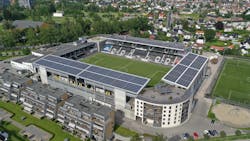Often it is a storm or other disaster that leads businesses to install a microgrid. But for a Norwegian soccer club, the impetus emerged as they began to view their arena roof differently.
“This project kicked off with a wild idea that it must be possible to use the roof of our arena for something useful,” said Einar Håndlykken, managing director of Odd’s Ballklubb, a soccer club determined to be the greenest in Europe.
Indeed, the Skagerak Arena proved a roof could be far more than a shelter. The roof now sports 18,790 square feet of solar panels that serve as the core of a sophisticated microgrid that not only feeds energy to the stadium but also serves 15 nearby homes in Skien, Norway, a city of 55,000 inhabitants.
In addition, the facility acts as a learning lab for the local utility, Skagerak Nett, helping it collect insights into the operation of a prosumer system — one that both consumes and produces energy in its relationship with the utility.
Called the Skagerak Energilab, the microgrid operates with 800 kW of solar, paired with an 800 kW/1100 kWh battery, which serves the arena’s 375,000 kWh load in concert with power from the local utility.
Soccer club energy use spikes
A multi-tasking controls system and automated energy management helps the soccer club achieve goals to save money, green its energy supply and keep the lights on.
Electric load more than doubles on game days, a common phenomenon for sports matches, but the microgrid helps manage costs through peak shaving. The microgrid assists the soccer club with its green goals by maximizing the use of the on-site solar. At the same time, the system ensures that there are no power outages, especially during soccer matches.
Evolution of the ABB microgrid
An ABB project, the Skagerak Energilab began operating last summer, and serves as an example of the evolution of the company’s microgrid play. ABB has been in the microgrid business for 30 years, initially building remote microgrids, some with flywheels at the core. It is now responsible for 170 microgrid and battery energy storage system installations. Totaling 450 MW worldwide, the ABB projects can be found in remote communities, islands, utilities and industrial campuses.
How has the microgrid changed over the decades?
Many of the principles and operations are the same, but automation serves as the new “secret sauce,” said Maxine Ghavi, senior vice president and head of the Grid Edge Solutions Business at ABB in a recent interview.
Automation, which is being modeled at the arena, improves the control, optimization and energy management undertaken by a microgrid. Depending on a microgrid’s configuration, it can ensure maximum use of renewables, minimum use of fossil fuel, and seamless transition from one generation source to another. Combine automation with energy storage, and the microgrid also has the ability to leverage electricity markets where rules allow.
Automation impacts the overall cost and environmental impact by allowing for integration of more renewable energy and reduction of diesel in power production, Ghavi said.
And now, combined with digitization, automation is leading to better data management. “We can process data faster, and therefore, from that perspective, respond faster,” she said. “The other thing you’re able to do through automation and digitalization is better monitor your asset’s health and make decisions faster.”
Calling those with large roofs
Once just a club wondering about the value of its roof, the Skagerak Arena is now a testing ground for many of these microgrid advancements.
“Skagerak Energilab is a good example of how grid edge technology transforms the power ecosystem. This is an important step toward obtaining field data and insights about tomorrow’s power grids,” said Steffen Waal, managing director of ABB in Norway.
Added the ball club’s Håndlykken,“Now, I hope this solution inspires others with a large roof to collaborate with those developing our energy systems.”
Learn more about microgrid innovation. Join us for the free Microgrid Knowledge Virtual Conference June 1-3.








